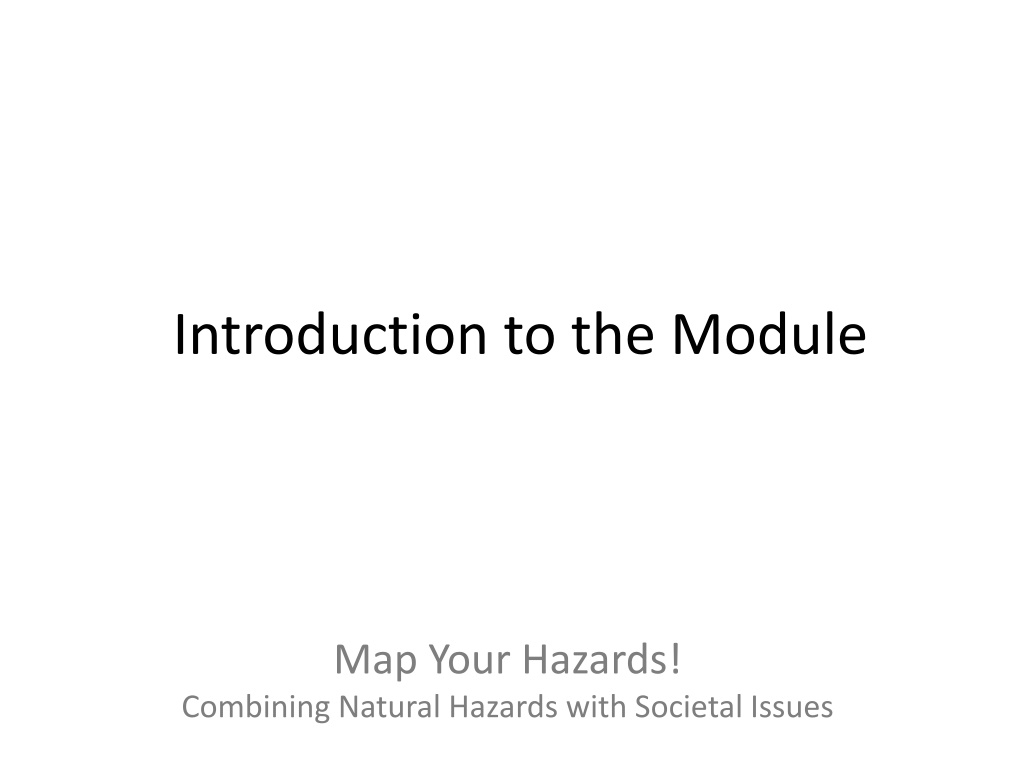Map Your Hazards Module Overview: Identifying Natural Hazards and Social Vulnerabilities
Explore the Map Your Hazards Module, a comprehensive program designed to help communities identify natural hazards, assess social vulnerabilities, and enhance preparedness. Through tasks like local risk mapping and social surveys, learn to mitigate risks and support communities in facing potential disasters.
Download Presentation

Please find below an Image/Link to download the presentation.
The content on the website is provided AS IS for your information and personal use only. It may not be sold, licensed, or shared on other websites without obtaining consent from the author. Download presentation by click this link. If you encounter any issues during the download, it is possible that the publisher has removed the file from their server.
E N D
Presentation Transcript
Introduction to the Module Map Your Hazards! Combining Natural Hazards with Societal Issues
Vision of Module Have you ever wondered . . . What natural hazards are likely to affect my town? How destructive can natural hazards be in my town? What groups of people are more at risk from these natural hazards? What can we do as a community to prepare and prevent a natural hazard event from becoming a disaster? Joplin tornado, EF-5, May 2011
Vision of Module The Map Your Hazards! Module will guide YOU to: Identify hazards and social vulnerability for YOUR town using credible geologic and social science datasets Collect and evaluate survey data on the knowledge, risk perception and preparedness within YOUR local social network Make recommendations to enhance preparedness within YOUR community Volunteers assist Hurricane Katrina victims at the Houston Astrodome.
Introduction The following slides are to introduce the instructor and you to: Supporting materials (files) available on the module web page Tasks to complete the module with suggested point values Enjoy learning about natural hazards, vulnerabilities, risk and risk perception in YOUR community! Coastal erosion, California, 1997. Northridge Earthquake, CA, January 17, 1994.
Module Overview Three parts to the Map Your Hazards! Module 1) Unit 1 Local Risk Map (22 points) 2) Unit 2 Social Survey (48 points) 3) Unit 3 Presentation (30 points) Oakland, CA firestorm, 1991.
Module Overview Files Introduction to the Module (this PowerPoint) Student Road Map and Grading Scheme for Module Unit 1 Student Instructions Unit 2 Student Instructions Unit 3 Student Instructions
Unit 1 Take pre-module quiz (2 points) Distribute Unit 2 Natural Hazards Survey (2 points in Unit 2 Part A Rubric ) Instructor will provide link to survey Personally take the Unit 2 Natural Hazards Survey Develop local risk map (20 points)
Local Risk Map Natural Hazards Get Hazard Map Template from instructor Instructor will hand out Unit 1 Rubric for map assessment Locate regions within the map that are susceptible to hazards Please read PowerPoint Tutorial for Unit 1
Local Risk Map Vulnerabilities Locate the following vulnerabilities on your map: Major transportation routes Major bridges Hospitals Retirement homes Schools Low-income areas Use Environmental Justice map: EJView http://epamap14.epa.gov/ejmap/entry.html You may wish to include additional vulnerabilities
Local Risk Map Combined Combine composite hazard map and vulnerability map in a new slide Determine areas of: Very high risk (maroon) High risk (red) Moderate risk (orange) Low risk (yellow) Include a key Explain reasoning for risk level assignment
Unit 1 Files PowerPoint files for class discussion prior to starting Unit 1: Introduction to Natural Hazards Introduction to Risk and Vulnerability (Geoscience or Social Science) Credible Data Interpretation Links for US Hazard Maps Word Document files for prior to starting Unit 1: Articles on Hazards and Risks Pre-module Quiz Files to help complete Unit 1 assignments: Unit 1 Student Instructions Unit 1 Rubric Hazard Map Template PowerPoint Tutorial for Unit 1
Unit 2 Part A Complete hazards survey prior to beginning Unit 2 (2 points). Analyze and discus survey data packets using Unit 2 Part A Worksheet (13 points) Unit 2, Part A Rubric Data packets will be provided by instructor Worksheet found in Unit 2 Student Instructions.
Unit 2 Part B Analyze entire survey data, and develop and test additional research questions using Unit 2 Part B Worksheet (33 points) Unit 2, Part B Rubric Worksheet found in Unit 2 Student Instructions For help using Excel refer to the Help for Excel file.
Unit 2 Files Files for prior to starting Unit 2: Natural Hazards Survey Excel Template for Research Questions Files to help complete Unit 2 assignments: Unit 2 Student Instructions Unit 2 Part A Rubric Unit 2 Part B Rubric Help for Excel Optional Files: Introduction to Social Survey Methodology Coding for Excel Analysis
Unit 3 Work with your instructor to obtain a stakeholder. Determine how to best share map and survey results with your stakeholder. Make recommendations to the stakeholder for building stronger community resilience.
Unit 3 Final Presentations Prepare a 5 7 minute PowerPoint presentation. Turn in a copy of your PowerPoint presentation beforepresenting. (1 point) Practice your presentation with a peer group. (1 point) Give feedback to another peer group using Unit 3 Rubric. (1 point) Present to the class (and other invited guests!) (23 points) Take post-module quiz. (2 points) Complete reflection questions. (2 points)
Unit 3 Files PowerPoint file for class discussion prior to starting Unit 3: Introduction to Stakeholders Files to help complete Unit 3 assignments: Unit 3 Student Instructions Unit 3 Rubric Files for post-module feedback: Post-module Quiz Reflection Questions For Geoscience Courses For Social Science Courses























